Facts
| Terrain: | Road |
|---|---|
| Arch support: | Neutral |
| Weight: | Men: 221g | Women: 190g |
| Heel to toe drop: | Men: 4mm | Women: 4mm |
| Pronation: | Neutral Pronation |
| Arch type: | High arch |
| Strike Pattern: | Forefoot strike |
| Distance: | Competition |
| Heel height: | Men: 23mm | Women: 23mm |
| Forefoot height: | Men: 19mm | Women: 19mm |
| Release date: | Jan 2018 |
| Brand: | Saucony |
| Type: | Low drop |
| Width: | Men: Normal, X-Wide | Women: Normal, X-Wide |
| Price: | €140 |
| Colorways: | White, Grey, Orange, Blue, Green, Purple, Black |
| Special editions: | 1 special editions |
Rankings
Expert Reviews
Experts are runners, who post reviews at youtube, directly at RunRepeat or at their own websites. Each expert is categorized from level 1 to level 5 based on expertise. See stats on expert reviews and how we calculate scores here.
Are you an expert? Apply to contribute here.
92 / 100 based on 16 expert reviews
-
Review of Saucony Kinvara 10’s after 200 miles
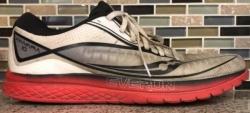
 More photos
More photos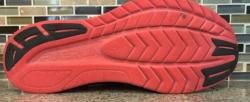
I never thought I could love a brand besides New Balance until I ran my first miles in these bad boys.
I had always been a fan of New Balance and owned multiple pairs, but one day decided to branch out and give Saucony a try.

I am a neutral runner and have always loved the lighter training shoes. So, when someone recommended me to try the Kinvara 10, I thought why not.
I usually run 7–8 min per mile. Regardless, this lightweight yet cushiony shoe is delightful to run in. I look forward every day to be able to take a spin in these.
First Wear
During my first time trying these shoes on, they fit very snug, especially around the back of my heel. Although tight, these were still breathable and very cushiony. I knew I had to give these a try.
Not only is the comfort great, but also the aesthetics of the shoe are phenomenal, such as the awesome logo on the side of the heel.
First Run
My first run in the Kinvaras was a 5-mile long run on the road. They were definitely tight compared to some of my previous trainers. But, I knew they still had to be broken in.
There's no doubt that these are the most comfortable trainers I've ever had on my first run, and they still are today 200 miles later.
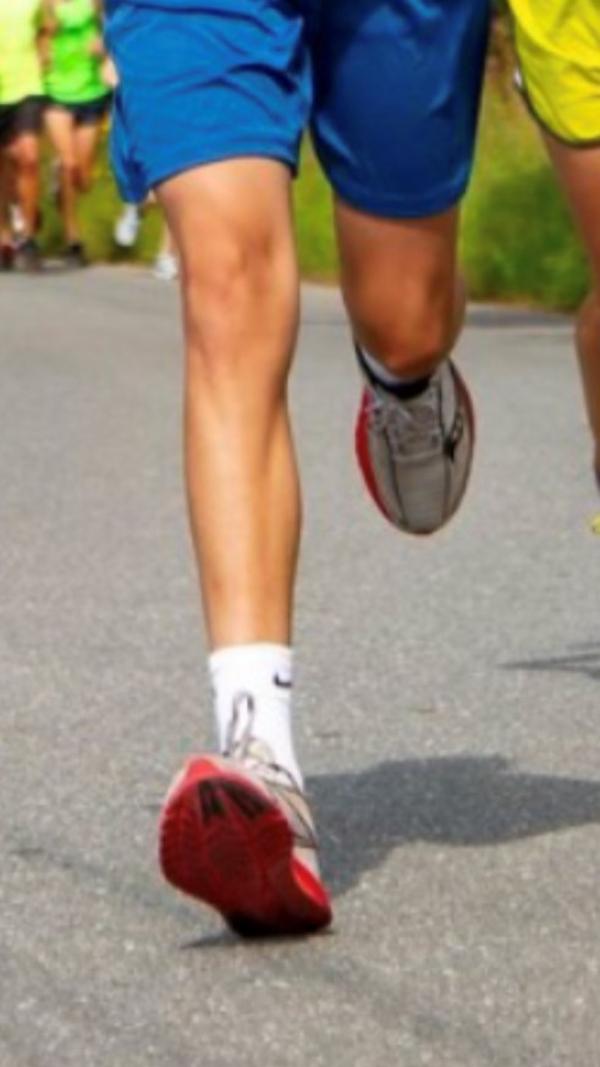
The Kinvaras in the middle of a 7 mile long run. This heel strike is really hurting my eyes.Performance
I have used these shoes on roads and trails and have never felt uncomfortable on a run because of them.
I have ran on grass, asphalt, concrete, wood, and dirt with these. Regardless of the surface I'm running on, these provide the same comfort—all thanks to the shoes' fantastic cushioning.
I never feel awkward when I land, and I owe that to the comfortable cushioning on the inside of the back end of the shoes.
Durability
The only aesthetic flaw that I have so far would be how dirty these get after trail runs. Dirt has gotten stuck in the mesh upper of the shoe.
Unfortunately, no amount of soap or hand-washing has been able to get it out. I am not willing to wash them, so the white has changed into more of a gray/brown.
Although the mesh upper on the shoe may get dirty after trail running, it doesn’t mean that it isn’t durable. The upper has not shown any signs of ripping now after 200miles, so that's a great sign.

The sole is still in excellent shape after countless trips and falls. It still looks good as new.
There seems to be no wear, which is fantastic. Many of my previous shoes would have started to wear down by this point.
Conclusion
The fact that these shoes have made me feel no pain after countless trips and falls proves the comfort and stability that many people rave about.
A lightweight yet stable shoe with almost no flaws, in my point of view, deserves a 98/100.
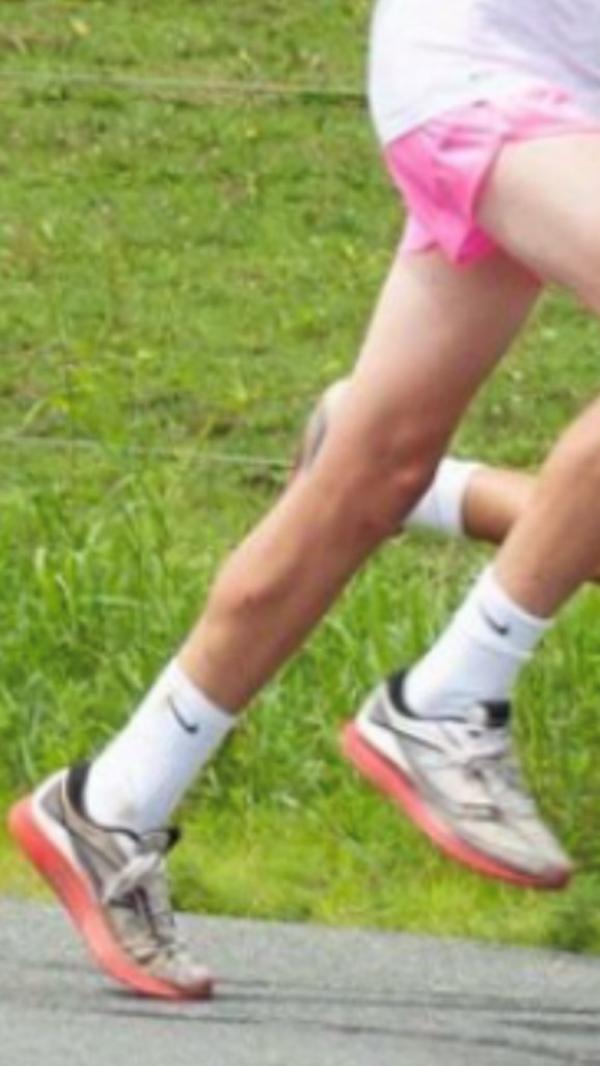
Saucony Kinvara 10 in action during a long run on asphaltFrom what I have heard about the Hoka Clifton 6, the Kinvara 10 seems like a more lightweight alternative for a neutral runner like myself.
Many people complain about the durability and wear of many Nike and New Balance shoes. On the other hand, I have even been told by people that Sauconys do not last.
But, from my experience, these have made it to 200 miles and seem like they can last to 500!
I may even have to buy another pair for when this pair decides to give in eventually because of my love for this shoe!
This expert has been verified by RunRepeat. Reviews are neutral, unbiased and based on extensive testing.
-
Saucony Kinvara 10: The legend continues
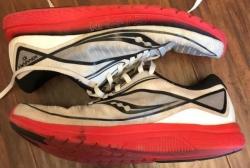

In a hurry? Read this: If you love neutral running shoes, you’ll want to add the Kinvara 10 to your lineup!
The locked-in heel construction combined with a responsive EVA+ midsole and Everun® topsole creates a premier lightweight, yet cushioned trainer. From long tempos to short track work, the Kinvara performs admirably.
In it for the long run? Read on.
Shoe specs
The Kinvara 10 weighs in at a 6.7oz for women and 7.8oz for men. The 4mm heel-toe offset is as minimal as it comes for mainstream trainers outside of Altra’s zero-drop niche. The 23mm stack height of the heel provides notable cushion while keeping the shoe lightweight.
Outsole changes
The EVA+ midsole doubles as the Kinvara 10’s outsole—cutting down on weight. Previous Kinvara models have done the same but encountered problems with the EVA foam becoming worn down and slick with use.
Saucony has attempted to remedy this issue by adding a layer of rubber to the back of the heel and front of the toe. This provides much-needed grip for the foot during heel strike and toe-off without weighing down the shoe in the excessive tread.
My Kinvara 10s after 150 miles
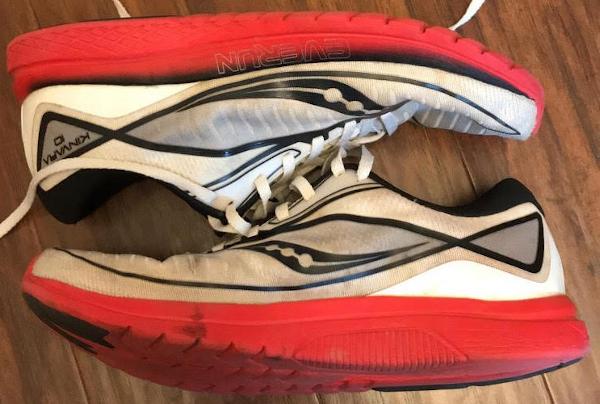
On the roads
The Kinvara 10 requires no break-in time. This is because the flexible sole allows the shoe to contour to your foot strike from the first step (notice the bend in the front of my shoes). I never once experienced blisters in the Kinvara 10.
The roomy toe box gives the foot plenty of space, and I found my heel was both snug and well padded. The strategically placed rubber on the outsole provides good tread even in wet road conditions.
Individual-specific concerns
For those used to running in more narrow shoes, the wide toe box might feel clunky.
Another concern is the low heel-to-toe drop. If you are inexperienced with running in low-drop shoes, your Achilles and calf muscles may feel strained upon first use. This will be especially true after fast or uphill running.
On the flip side, low-drop shoes tend to strengthen the feet and low legs, but it takes time to make the transition injury-free.
On the trails
The Kinvara is not a trail shoe. Thus, it lacks the more aggressive tread preferable for regular trail use.
However, the Kinvara still performs exceptionally well on easier trails. I ran a successful tempo workout on a mixed route of dirt trails and gravel roads.
On one particularly rocky section, I wished I had a firmer shoe with more robust support. A stretch of downed, wet leaves also tested the limits of the Kinvara tread.
At the same time, I felt the shoe was in some ways advantageous for navigating trails. The toe box gave my foot a wider support platform and made it harder to twist an ankle on exposed roots.
Flexibility in the sole allowed the shoe to ebb and flowed with the terrain. If you’re a nimble runner, the Kinvara can easily adapt to light trail use.
Some things don’t change
I bought my first pair of Kinvaras as a sophomore in high school. On the first day I wore the shoe, I remember jogging out to meet the track team for warmups.
I was keenly aware of the comical, bright-green color scheme. It looked like someone covered my shoes in highlighter. But I didn’t care, I felt fast.
Many years and several Kinvara models later, the shoe continues to provide users with a sense of speed (although, I am not convinced the colors have improved much).
Now, on its 10th-anniversary edition, the Kinvara rightfully claims that a lightweight running shoe can pack a heavyweight punch.
Saucony has kept the Kinvara 10 true to everything that made its earlier versions great but added improved technology and useful additions to tread.
The sun has yet to set on this iconic shoe.
View from the trail

This expert has been verified by RunRepeat. Reviews are neutral, unbiased and based on extensive testing.
-
Long runs, short runs, fast-tempo runs, this shoe can handle it all. It's one of those great shoes. If you only have one shoe in your locker, this is the one to have.
-
Is the Kinvara 10 a buy, a try or a why? In this case, I'm leaning towards why. Only because there are so many versios of the shoe previous that I enjoyed so much.
- The Saucony Kinvara 10 is a daily running shoe that’s meant for those who desire an efficient product for their everyday exercises or speed training sessions. The upper unit is made up of engineered mesh, a cloth-like textile that accommodates the natural shape and motion of the foot as it transitions from the heel to the toe. Thin overlays hold the foot in place, preventing unintentional in-shoe wobbling. Discreet pods are placed in the heel to cushion the sides and avert accidental shoe removals.
- The 10th version of the Kinvara has a full-length cushioning system that’s meant to protect against impact shock while enabling reactive steps. Two layers of foam work together to ensure consistent cushioning that doesn’t easily sag. While most of the outsole is made up of ground-contact foam, there are rubber nodes on high-wear areas to alleviate the potentially damaging nature of the asphalt.
The Saucony Kinvara 10 was designed using the standard measurements. When it comes to size, men and women can expect options that range from full sizes to half-sizes. Widthwise, the usual choices are available, allowing those with medium foot dimensions to ease into the shoe effortlessly. A semi-curved outline and a slightly wide forefoot design permit natural toe-splay.
Ground-contact EVA+ is the material used for the midsole unit of the Saucony Kinvara 10. This compound is capable of resisting the damaging effects of surface contact and rubbing. It has textured sections that are responsible for traction.
The areas of the heel and forefoot that are more prone to damage and wear are covered with rubber. These nodes are tasked with heightening durability and ensuring grip.
The Tri-Flex design is made up of flex grooves that have a three-pointed pattern. These points are meant to permit the natural movement of the human foot, freeing the runner to perform instinctively throughout the running session.
EVERUN™ is a full-length topsole that energizes the foot as it takes each step. It has been constructed to retain its form even after many uses. It is also lightweight so it won’t feel as if it’s going to mar down the experience.
EVA+ serves as the base of this running shoe‘s entire cushioning system. It has a substantial thickness that allows it to balance the foot and maintain its form throughout the performance.
FORMFIT is a footbed that is placed on top of the primary cushioning system. The purpose of this material is to add some more to the underfoot experience. It is contoured to take the shape of the foot-pad, supporting the curves and crevices which aren’t usually given attention.
The upper unit of the Saucony Kinvara 10 utilizes the cloth-like performance of engineered mesh. This fabric is soft and has a seamless construction. It has a predominantly close-weave format for durability, though there are many open-weave sections for targeted breathability and flexibility. The engineered mesh is also stretchy. Thus it allows the foot to relax and move naturally as it goes through the gait cycle.
The collar and tongue are padded. These elements help in keeping the foot in place while also ensuring extra cushioning for the upper portions of the foot.
The internal lining is made of a smooth and non-irritating textile. The purpose of this inner sleeve is to accommodate a foot that isn’t covered by a sock. Sock-less wearing may result in hot spots and chafing, but the soft interior prevents such occurrences.
Internal Heel Pods are placed on the left and right parts of the inner collar. These cushioned add-ons are meant to heighten the in-shoe comfort that the runner is supposed to feel. They are also tasked with maintaining the position and steadiness of the foot while also preventing accidental or unintentional shoe removals.
The Flex Film overlay system is made up of a thin material that is welded onto the upper unit of the Saucony Kinvara 10. This surrounding layer helps the rest of the façade when it comes to holding the foot securely. It also provides some visual flair and brand recognition as the Saucony logo, and the words ‘KINVARA 10’ are part of this sheet.
‘Head of the sea’ is the literal translation of the word ‘Kinvara.’ The name is also used for a County Galway, Ireland village-by-sea. The peaceful yet wild nature of the sea became the inspiration for one of Saucony’s most famous series of road running shoes.
The Kinvara line of performance footwear started in the year 2009. The initial version was crafted because a lot of consumers were pining for a running companion that didn’t have a substantial heel-to-toe drop yet featured a lightweight and uncluttered build.
The original Kinvara model was described as a close-to-the-ground daily trainer that may pass off visually as a casual sneaker. But it apparently held a high-quality construction that permitted runners to tackle the roads with ease and sureness. Stitch-reinforcements highlighted the upper, though some fused overlays were already utilized.
The natural underfoot experience that people desired came from the Kinvara’s (1st) 4-millimeter drop. Seldom did performance shoes have such a platform, so people loved that steady plane. The height of the midsole relative to the ground was also clearly seen, though its light construction didn’t limit quick steps. For many, such a design paved the way for pseudo-minimalist running shoes that many seem to enjoy nowadays.
The 10th anniversary of the Kinvara series celebrates its roots by having a design that’s reminiscent of the original façade. An optional colorway also remembers the two-tone hues of the classic model, evoking a sense of nostalgia among purists and followers of the line.
Still, Saucony hasn’t forgotten the value of moving forward and making new things happen for their consumers. Alas, the Kinvara 10 now has a few recent technologies like the EVERUN™ cushioned layer, the durable yet shock-attenuating EVA+, the FORMFIT supportive footbed, and the sock-like engineered mesh upper.
Mizuno Wave Sonic
Low-drop running shoes weren’t highly pervasive before the 2010s. But after the Saucony Kinvara proved that agreeable cushioning didn’t need a heavy profile and a bevy of features. The Wave Sonic from Mizuno is performance footwear that follows in that product’s footsteps; it gained praise for having a responsive underfoot experience, reliable traction via its outsole’s gripping lugs, and attractive looks that enabled fashionable use. The upper of this shoe offers breathability and security albeit in a silhouette that isn’t laden with thick overlays.
Asics Kanmei MX
A neutral running shoe that deceptively looks plain; that’s the aura of the Asics Kanmei MX. This product doesn’t have a lot of bells and whistles. It actually looks like a casual sneaker that took its inspiration from performance footwear. Cushioning is given by a foam midsole that runs the entire length of the silhouette. Flex grooves on the external pad are crafted as a means to permit natural movement through the gait cycle. The upper unit features an open-weave mesh that allows air into the foot-chamber effortlessly, thereby ensuring a well-ventilated in-shoe experience. Printed overlays help the traditional lacing system in securing the foot and preventing unnecessary movements when idle or when taking each step.
New Balance 730 v3
The New Balance 730 v3 moves away from the design of its immediate predecessor, the 730 v2 because it uses a very minimalistic approach for its façade. A compression-like coverage is applied via printed overlays with a little stitching. The midsole unit of this neutral running shoe is made up of the Acteva Lite, a full-length foam that is touted to be lighter than the regular ethylene vinyl acetate (EVA) variant by roughly 24%. Many consumers treated this iteration as a vast improvement over the previous ones, with several stating that it was highly effective at accommodating the natural movement of the foot as it takes each step.














